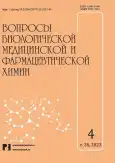Novel 6,7-dimethoxyquinazolin-4(3H)-one derivatives as promising compounds for the therapy of alzheimer's disease
- 作者: Pozdnyakov D.I.1, Chiryapkin A.S.1, Kodonidi I.P.1
-
隶属关系:
- Pyatigorsk Medical and Pharmaceutical Institute
- 期: 卷 26, 编号 4 (2023)
- 页面: 23-27
- 栏目: Pharmaceutical chemistry
- URL: https://journal-vniispk.ru/1560-9596/article/view/143127
- DOI: https://doi.org/10.29296/25877313-2023-04-04
- ID: 143127
如何引用文章
详细
Relevance. Alzheimer's disease is one of the most common forms of dementia with a high mortality and disability rate. Some quinazolinone derivatives having methoxy groups in the quinazolinone scaffold may be potentially effective agents for the treatment of Alzheimer's disease.
The aim of the study. To evaluate the effect of new derivatives of 6,7-dimethoxyquinazoline-4(3H)-one on the activity of acetylcholinesterase and the aggregation of amyloid particles process under experimental conditions
Materials and methods. The studied derivatives of 6,7-dimethoxyquinazoline-4(3H)-one with amino acid and dipeptides residues were obtained by replacing the oxygen heteroatom in the benzoxazinone core by boiling the initial compound with the corresponding amino acid. The anticholinesterase activity of the studied compounds was evaluated using an Ellman reagent with spectrophotometric detection of degradation products of 5.5'-dithiobis-2-nitrobenzoic acid. The antiamyloid activity of 6,7-dimethoxyquinazoline-4(3H)-oh derivatives was determined by a change in the intensity of aggregation of β-amyloid particles (fragment 1-42) with congo red. All tests were performed three times.
Results. As a result of the study, it was found that derivatives of 6,7-dimethoxyquinazoline-4(3H)-oh inhibit the activity of acetylcholinesterase in vitro with IC50 values in the range of 1.8±0.36 mg/ml to 4.2±0.96 mg/ml, which corresponded to the indicators of the referent - donepezil (IC50 = 2.4±0.06). It is also worth noting the presence of moderate antiamyloid properties of the studied substances, which reduced the aggregation of β-amyloid particles by more than 50%, which, however, was lower than the indicators of the referent - GV-791 (p<0.05). Among the studied substances, the highest level of activity was characterized by substances containing glycylglycine and glycylleucine residues in the structure, surpassing donepezil (p<0.05) in the ability to inhibit acetylcholinesterase.
Conclusion. The study showed that derivatives of 6,7-dimethoxyquinazoline-4(3H)-one with amino acid and dipeptides residues, in particular with fragments of glycylglycine and glycylleucine, can be promising objects for further development of drugs for the treatment of Alzheimer's disease with a predominant effect on acetylcholine metabolism.
作者简介
D. Pozdnyakov
Pyatigorsk Medical and Pharmaceutical Institute
编辑信件的主要联系方式.
Email: pozdniackow.dmitry@yandex.ru
Ph.D. (Pharm.), Head of Living System Laboratory, Associate Professor of Department of Pharmacology with Clinical Pharmacology Course
俄罗斯联邦, PyatigorskA. Chiryapkin
Pyatigorsk Medical and Pharmaceutical Institute
Email: alexey.chiriapkin@yandex.ru
Post-graduate Student, Department of Organic Chemistry
俄罗斯联邦, PyatigorskI. Kodonidi
Pyatigorsk Medical and Pharmaceutical Institute
Email: kodonidiip@mail.ru
Dr.Sc. (Pharm.), Professor of the Department of Organic Chemistry
俄罗斯联邦, Pyatigorsk参考
- Breijyeh Z., Karaman R. Comprehensive Review on Alz-heimer’s Disease: Causes and Treatment. Molecules. 2020; 25: 5789; https://doi.org/ 10.3390/molecules25245789.
- Mehta R.I., Schneider J.A. What is ‘Alzheimer's disease’? The neuropathological heterogeneity of clinically defined Alzhei-mer's dementia. Current opinion in neurology. 2021; 34(2): 237–245; https://doi.org/10.1097/WCO.0000000000000912.
- Stanciu G.D., Luca A., Rusu R.N. Bild V., Beschea Chiriac S.I., Solcan C., Bild W., Ababei D.C. Alzheimer’s Disease Pharma-cotherapy in Relation to Cholinergic System Involvement. Bio-molecules. 2020; 10(1): 40; https://doi.org/ 10.3390/biom10010040.
- Hur W.S., Flick M.J. Aβ peptide and fibrinogen weave a web of destruction in cerebral amyloid angiopathy. Proceedings of the National Academy of Sciences. 2020; 117(27): 15391–15393; https://doi.org/ 10.1073/pnas.2009999117.
- Cortes-Canteli M., Iadecola C. Alzheimer’s disease and vascu-lar aging: JACC focus seminar. Journal of the American College of Cardiology. 2020; 75(8): 942–951.
- Оганесян Э.Т., Кодониди И.П., Магонов М.М., Иванов Р.В., Кулешова С.А., Ивашев М.Н., Али Алькаф, Смирнова Л.П., Ротенко А.А. Прогноз и целенаправленный синтез n-гете-роциклических производных хиназолинона-4. Современные наукоемкие технологии. 2004; 6: 109–110 (Oganesjan Je.T., Kodonidi I.P., Magonov M.M., Ivanov R.V., Kuleshova S.A., Ivashev M.N., Ali Al'kaf, Smirnova L.P., Rotenko A.A. Prognoz i celenapravlennyj sintez n-gete-rociklicheskih proizvodnyh hinazolinona-4. Sovremennye naukoemkie tehnologii. 2004; 6: 109–110).
- Chiriapkin A.S., Kodonidi, I.P., Pozdnyakov D.I. Synthesis and evaluation of cerebroprotective activity of novel 6,7-dimetho-xyquinazolin-4(3H)-one derivatives containing residues of ami-no acids and dipeptides. Chimica Techno Acta. 2022; 9(2): 20229212; https://doi.org/10.15826/chimtech.2022.9.2.12.
- Chiriapkin A.S., Kodonidi I.P., Pozdnyakov D.I., Zolotych D.S. Synthesis and QSAR of new azomethine derivatives as agents for the treatment of Alzheimer's disease. Pharmacologyon-line. 2021; 3; 563–584.
- Chiriapkin A.S., Kodonidi I.P., Pozdnyakov D.I., Glushko A.A. Synthesis, in vitro and docking studies of 2-substituted 5,6,7,8-tetrahydrobenzo[4,5]thieno[2,3-d]pyrimidine-4(3H)-one deriva-tives as agents for the treatment of Alzheimer's disease. Chimica Techno Acta. 2022; 9(2): 20229204; https://doi.org/10.15826/ chimtech.2022.9.2.04.
- Jończyk J., Godyń J., Stawarska E., Marak-Mlodawska B., Jelen M. Pluta K., Malawska B. Dual Action of Dipyridothia-zine and Quinobenzothiazine Derivatives-Anticancer and Cho-linesterase-Inhibiting Activity. Molecules. 2020; 25(11): 2604; https://doi.org/10.3390/molecules25112604 32.
- Wang W., Zhao C., Zhu D., Gong G., Du. W. Inhibition of amy-loid peptide fibril formation by gold-sulfur complexes. J Inorg Biochem. 2017; 171: 1–9; https://doi.org/10.1016/j.jinorgbio. 2017.02.021.
补充文件










